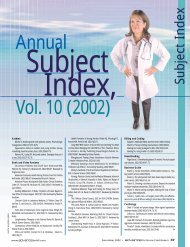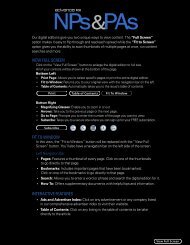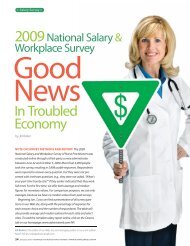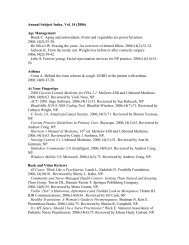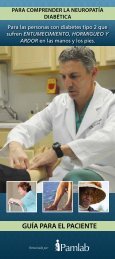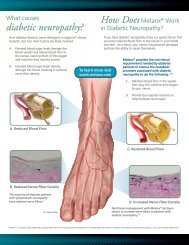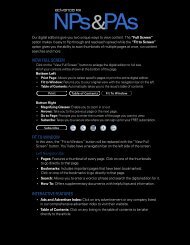CME/CE: PharmacologyMan vs. MicrobeTreatment issues in an age of antibiotic resistanceBy Lynn A. Kelso, MSN, APRN, FCCM, FAANP➼ In the late 1960s, U.S. SurgeonGeneral William H. Stewart was attributedwith the following bold statement:“It is time to close the book on infectiousdiseases and declare the war againstpestilence won.” An increase in vaccineshad produced a dramatic decrease in theincidence of infectious diseases such assmallpox and polio, and multiple new antimicrobialagents were available to treatthe organisms that were causing infections.It appeared that we had an upperhand on infectious microbes. However,with increased and widespread use ofantimicrobial agents to prevent or treatinfections, resistance patterns continuedto emerge. It soon became clear that wewould never be able to defeat antimicrobialresistance. At best, we would needto keep pace with it.The mass production of penicillin, thefirst antibiotic, began in 1943, after theoutbreak of World War II. Just 4 yearslater, resistance to penicillin had developed.Many new antimicrobial agentshave been discovered and developed sincethen, but microbes have continued tokeep pace and develop further resistance.This poses great risk to patients and greatchallenges to healthcare providers.The World Health Organization hasdeemed antimicrobial resistance oneof the three most important problemsfacing healthcare providers today. 1 TheLynn A. Kelso is an acute care nurse practitionerwho is an assistant professor in theCollege of Nursing at the University of Kentuckyin Lexington. She has completed a disclosurestatement and reports no relationships relatedto this article.Learning Objectives1. Identify the causes of antibioticresistance.2. Discuss the educational needsof patients related to the use ofantibiotics.kyle kielinski3. Describe antibiotics newly approved andin development.4. List three ways to prevent the spread ofMDRO infections.<strong>ADVANCE</strong> <strong>for</strong> <strong>NPs</strong> & <strong>PAs</strong>25
CME/CE: PharmacologyThe Food and Drug Administration and the Infectious Diseases Society ofAmerica have challenged pharmaceutical companies to develop 10 newantimicrobial agents by 2020.acronym ESKAPE is being used to summarizethe most important and concerningresistant microbes: Enterococcusfaecium, Staphylococcus aureus,Klebsiella pneumoniae, Acinetobacterbaumannii, Pseudomonas aeruginosaand Enterobacter species. 1In 2001, the Infectious Diseases Societyof America (IDSA) took action on itsconcerns about the lack of new, novelantimicrobial agents <strong>for</strong> gram-negativemultidrug-resistant organisms (MDROs).The IDSA worked with the Food andDrug Administration to develop a charge<strong>for</strong> pharmaceutical companies to develop10 new antimicrobial agents by 2020. 2We need new classes of antimicrobialsas well as new medications within existingclasses. Most recently introducedantimicrobial agents have focused onMDROs that are gram-positive organisms(see table). The development of antimicrobials<strong>for</strong> gram-negative organisms,particularly gram-negative bacilli, haslagged behind.Antimicrobial ResistanceBacteria can develop resistance to antimicrobialagents in various ways. Mutationof bacteria that have been exposed toantimicrobial agents can lead to thedevelopment of resistance to future useof the same medication. Bacteria can alsoshare genetic material that allows <strong>for</strong> thespread of antimicrobial resistance fromone species to another.Educating the public about the appropriateuse of antimicrobial agents isessential in the fight against increasingresistance. Patients who seek healthcareservices when they are sick often expecta prescription <strong>for</strong> an antibiotic, and it isup to healthcare providers to make thecorrect determination and to educatepatients about it. Proper drug and dosageselection are vital.Complicating the resistance problemis that it is easy to obtain antimicrobialmedications without a prescription.Advice about using pet antibioticsin humans is readily available on theInternet. The average pet supply storestocks numerous antimicrobial agents. Inthe fish aisle alone, ampicillin (Fish Cillin),tetracycline (Fish Cycline), cephalexin(Fish Flex), ketoconazole (Fish Fungus),amoxicillin (Fish Mox), erythromycin(Fish Mycin), and metronidazole (FishZole) can all be purchased in capsuleor tablet <strong>for</strong>m. A bottle of 100 capsulescan be purchased <strong>for</strong> less than what aprescription <strong>for</strong> a human would cost –and it will provide enough medicationto save <strong>for</strong> future use. In addition, manybodegas and other ethnic variety storessell antibiotics by the pill.This can seem to be a great alternative,particularly when many patientsare without health and prescription drugcoverage. It is paramount, however, thatpatients understand the risks associatedwith taking a medication that has notbeen prescribed <strong>for</strong> them.Another way patients try to save moneyis to stop taking a prescribed medicationas soon as symptoms disappear.Depending on the infection being treated,the appropriate length of antimicrobialtreatment may be 7 to 10 days. When thepatient begins to feel better by the thirdday of the treatment course, he or she maynot complete the entire prescription. Butthe infection may not yet be adequatelytreated, and stopping the medication canput the patient at risk <strong>for</strong> developing aresistant, more virulent infection in thefuture. A “survival of the fittest” conceptmay play a role in the development ofresistance when bacteria are exposed tobut not eradicated by antimicrobials.Because of the speed with which bacteriamultiply, mutations are common.However, the sharing of genetic materialis more problematic because resistance toa specific antimicrobial agent or class ofagents can then be transferred betweenorganisms.MDROs in the United StatesMultidrug resistance is defined as theresistance of an organism to at least oneantimicrobial in at least three antimicrobialclasses. 3 Multidrug-resistant,gram-positive organisms, particularlymethicillin-resistant S aureus, (MRSA)and vancomycin-resistant enterococci(VRE) are longtime concerns, and mostef<strong>for</strong>ts to generate new antimicrobialagents have focused on these organisms.While pharmaceutical companieshave made some ef<strong>for</strong>ts to developdrugs that are effective against MDROgram-negative organisms, infections bythese organisms have necessitated theuse of old antimicrobial agents such aspolymyxins. 1Although MDRO infections are a commonconcern in the hospital setting, ratesof MDRO infections in long-term carefacilities and in the community are rising.3 Patients who have been infected, orcolonized, with MDROs are dischargedto home or transferred to long-termcare facilities to continue treatment andrehabilitation. One study conducted at asingle long-term care facility found thatMDR gram-negative bacilli were isolatedfrom 11% of cultures, while MRSA andVRE were only isolated in 6% and 1% ofcultures, respectively. 3Extended-spectrum beta-lactamase(ESBL) infections in the community arerare, but the organism has been identifiedin urine cultures of patients in theoutpatient setting, including those whohave had no healthcare contact within6 months. 326 <strong>ADVANCE</strong> <strong>for</strong> <strong>NPs</strong> & <strong>PAs</strong>



